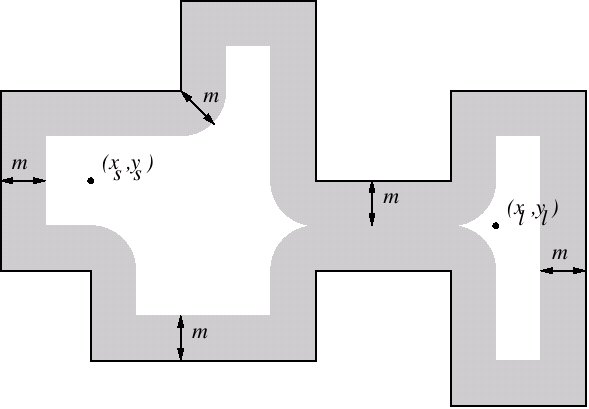
| Message in the Enemy Territory |
A group of commandos has been caught and sent to a maximum-security prison in enemy territory. In order to escape from the prison, a soldier needs to give a message to the squadron leader.
The boundary of the prison is protected by electronic alarms: for
his security, the soldier needs to keep a distance greater than m
from the boundary. An additional restriction is that the soldier can
only stand on those positions with integer coordinates. In each step,
the soldier can move, from a given position (x, y), only to the
nearby positions: (x - 1, y - 1), (x - 1, y),
(x - 1, y + 1), (x, y - 1),
(x, y + 1),
(x + 1, y - 1), (x + 1, y) and
(x + 1, y + 1), without going out
of the interior of the prison. The walls of
the prison form a simple polygon (no repeated vertices and no intersections
between edges) and all of them are parallel to
either the x-axis or the y-axis of a hypothetical coordinate
system. The following figure shows a typical prison's plan:

(xs, ys) and (xl, yl) corresponds to the position of the soldier and the squadron leader respectively. The gray area indicates those positions that are at distance less than or equal to m from the prison's boundary, i.e., the zone that the soldier cannot stand on.
A safe path is a sequence of pairs of integer coordinates, each one at a distance greater than m from the boundary of the prison, so that consecutive pairs are different and do not differ in more than one in each coordinate. In the depicted example, there is not a safe path from the soldier to the squadron leader.
Your task is to determine, for a given prison's plan, if there exists a safe path from the soldier position to the squadron leader position.
The problem input consists of several test cases. Each test case consists of three lines:
The end of the input is indicated by a line with ``0 0''.
For each test case the output includes a line with the word ``Yes'' if there exists a path from the soldier to the squadron leader. Otherwise the word ``No'' must be printed.
4 1 0 0 0 5 5 5 5 0 2 2 3 3 8 3 0 16 0 6 4 6 4 0 12 0 12 10 8 10 8 16 4 12 8 4 0 0
Yes No